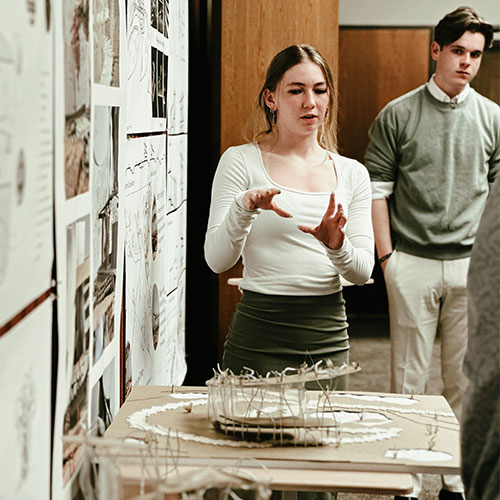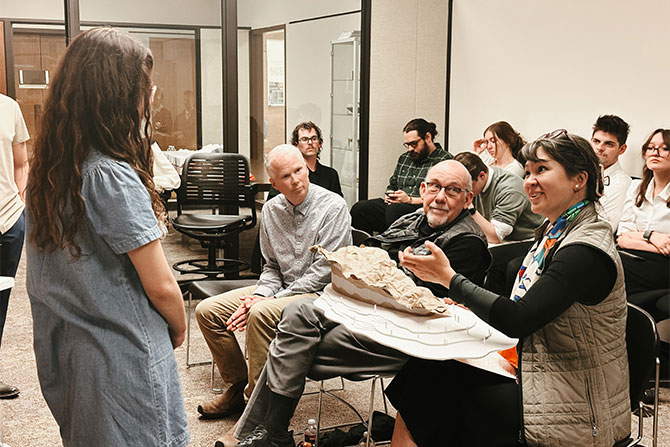Image Above: Shelley Bodily, AIA, Monica Chandler, AIA; SLCC Department of Architecture
In a time when architectural education is rapidly evolving to address new pedagogical, technological and professional demands, Salt Lake Community College’s (SLCC) Architecture Department stands as a case study in responsive and visionary transformation. At the helm of this evolution are Shelley Bodily, AIA, and Monica Chandler, AIA — two licensed architects, educators and mothers who are reshaping what a community college architecture education can look like in the 21st century.
Together, Bodily and Chandler are leading a multi-dimensional reinvention of SLCC’s program, addressing everything from curriculum structure to national engagement, technological integration and institutional visibility. Their work is transforming the department into a model of accessibility, academic excellence and design relevance.
A Career Path Rooted in Experience and Innovation
Shelley Bodily’s route into architecture — and architectural education — was not linear. Like many of her students, she began her academic journey in a different discipline, originally majoring in engineering before discovering a passion for design. That shift ultimately led her to SLCC, and later to the University of Utah, where she completed her formal architectural education.
After more than ten years in professional practice — including time with respected local firms such as Sparano + Mooney, ajc architects, Method Studio and collaborations with Louise Hill Design — Bodily transitioned into academia. Her years as an adjunct were marked by dedication to teaching core technical skills, especially in software instruction. She spearheaded updates to the Revit curriculum, authored the course manual, and created a companion video series to support a diverse range of learners. She also contributed significantly to the department’s early efforts at curriculum alignment with transfer institutions, helping to shape an educational foundation that was both rigorous and flexible.
Bodily’s impact expanded when she became the first woman in the department to be hired as full-time faculty. She later earned tenure, and in 2023, was promoted to associate dean of the Visual Art & Design Division (VAD) within SLCC’s School of Arts, Communication & Media (SACM) — the first architecture professor at the college to hold such a position. In 2024, Bodily stepped into the role of interim dean of SACM, where she now advocates for design excellence across all visual disciplines and works to create interdisciplinary opportunities that benefit students and faculty alike.
Beyond administrative leadership, Bodily has continually advocated for hands-on student learning. Her successful Perkins grant writing efforts secured the department’s laser cutters, 3D powder printers and improved computing labs. She also led initiatives such as the development of SLCC’s Design Foundations Workshops I-III and initiated early discussions for a proposed home design degree. She was instrumental in reinstating the Architecture Club — though the pandemic disrupted that progress — and continues to champion projects to refresh classroom environments.
Perhaps most notably, Bodily’s leadership is deeply informed by her understanding of what it means to begin in community college. As an SLCC alumna herself, she embodies the transformative potential of accessible education and serves as a living example for her students — especially her daughters, for whom she hopes to model what education and ambition can achieve.
Building Foundations and Visibility
Monica Chandler brings complementary strengths to the department’s leadership. Born in Brazil, Chandler is also an SLCC alumna who transferred to the University of Utah, where she earned her Master of Architecture. She became licensed after 14 years of professional work with firms such as Architectural Nexus and FFKR Architects before shifting her focus to education.
Chandler began teaching at SLCC as an adjunct in 2018, quickly developing a reputation for student-centered instruction and curricular precision. Since becoming a full-time, tenure-track assistant professor and department coordinator, Chandler has led a thorough and thoughtful curriculum overhaul — redefining course outcomes, aligning course numbers and titles with state-wide systems, and reinforcing articulation agreements with key transfer institutions. Her revisions to the architecture history sequence have given students a stronger grounding in architectural vocabulary, theory and cultural context — preparing them not just to transfer, but to think critically as emerging designers.
In response to Utah’s evolving general education requirements, Chandler introduced new architecture-specific courses that build student competency in design software, visual communication and presentation techniques — skills that had previously received limited formal attention in the curriculum. Her leadership has made a measurable difference in student attendance, retention and portfolio quality.
Chandler also recognized the importance of teaching presence and flexibility in the digital age. She partnered with SLCC’s eLearning division to develop and refine online and hybrid courses, completing multiple certifications in digital pedagogy. These efforts have not only supported diverse learning styles but have also expanded the department’s reach and resilience.
As coordinator — the first woman to hold this role in the department’s 30-year history — Chandler oversees course scheduling, faculty onboarding, program assessment, inventory, student workers and resource allocation. Her dedication has extended beyond administration into the public face of the department: She has elevated its visibility by curating student work in campus hallways, digital displays and social media platforms, while also maintaining a current stream of events and transfer information. Her work earned her the Outstanding First-Year Full-Time Faculty Award and a Scholarship of Teaching and Learning fellowship, where she is currently researching the applications of AI in architectural history and design instruction.
National Engagement and Strategic Alliances
Under Bodily and Chandler’s leadership, the SLCC Architecture Department has made substantial strides toward national professional integration. One of the most transformative shifts has been their department-wide participation in the Association of Collegiate Schools of Architecture (ACSA), which has connected SLCC faculty to a national network of educators and resources. Attendance at ACSA conferences and webinars has exposed SLCC to pedagogical trends, student work and course models from across the country, directly informing the structure and content of its evolving curriculum.
In addition, the department has joined the Coalition of Community College Architecture Programs (CCCAP), a peer organization that offers critical support and camaraderie for two-year architecture programs. These affiliations affirm SLCC’s commitment to maintaining both local relevance and national competitiveness, ensuring students are prepared not only to transfer but to thrive in the field.
The department’s ties to the University of Utah have also been significantly reinforced. Chandler regularly participates in design juries at the U, collaborating with faculty such as Jeff Davis, Erin Carraher, Timothy Adekunle and Patrick Tripeny. In return, SLCC hosts U of U faculty — including Michael Abrahamson, Valerie Greer and Emeritus Professor Bill Miller — for its own student reviews. These reciprocal exchanges are fostering a culture of continuity and rigor that benefits both institutions and deepens SLCC’s credibility as a serious entry point into architectural education.
Looking Ahead
Perhaps most exciting is the momentum SLCC is building toward broader recognition within the professional landscape. Recent dialogues between ACSA and the National Council of Architectural Registration Boards (NCARB) have explored the inclusion of community colleges in pathways to licensure. These conversations, once unlikely, reflect a growing acknowledgment that two-year institutions have a role to play in the diversification and democratization of the profession.
At SLCC, that potential is being realized with intention and care. The department’s leadership is not simply reacting to trends — they are helping to shape them. Bodily and Chandler’s shared background as SLCC graduates, licensed architects and committed educators gives them a unique and empathetic perspective on the challenges their students face. It also gives them the insight to design solutions that are both aspirational and grounded.
Their vision for the department includes a future where technical excellence and design thinking go hand in hand, where community college students are seen as full participants in the architectural dialogue, and where the value of accessible, high-quality education is not just defended — but celebrated.
The transformation of SLCC’s Architecture Department under Shelley Bodily and Monica Chandler offers a compelling model for other two-year programs. Through clear-eyed leadership, strategic collaboration and a deep commitment to student empowerment, they are not only renewing the department’s direction — they are redefining what’s possible.
Click to view the revamped SLCC Architecture Department website.









